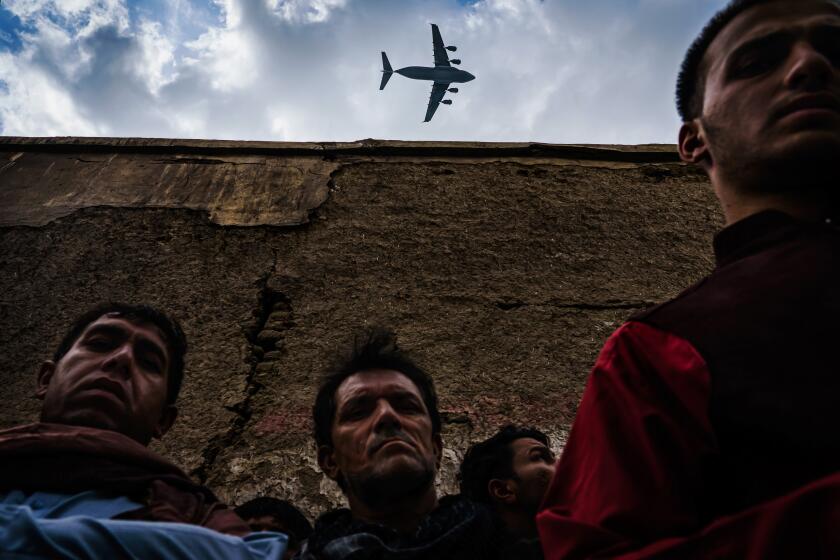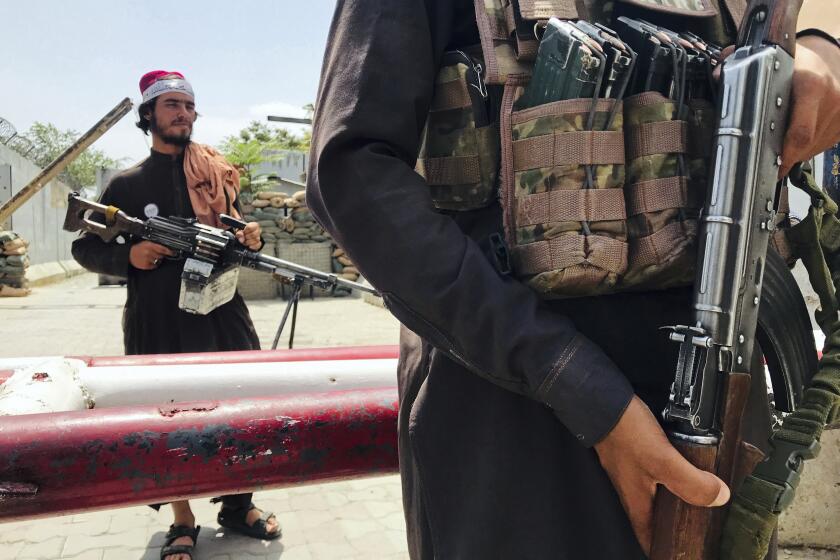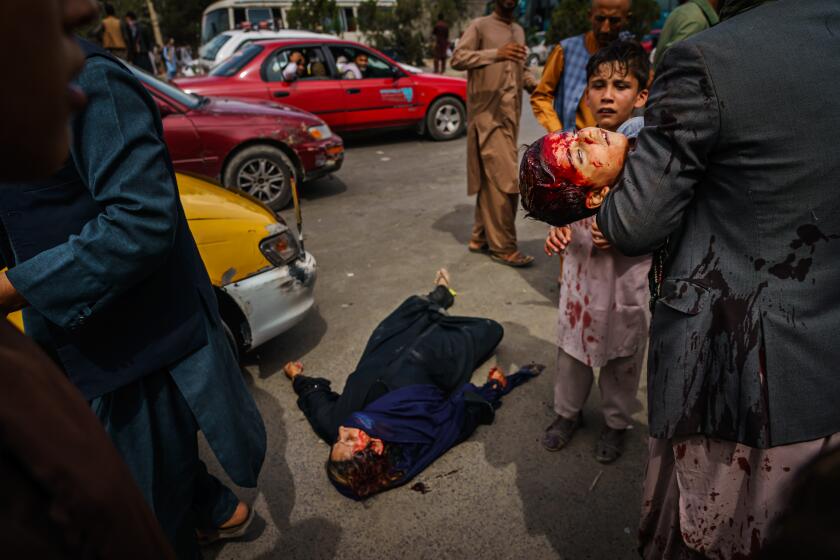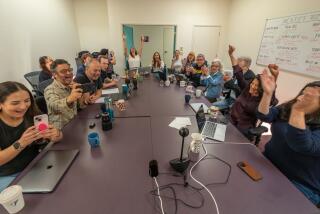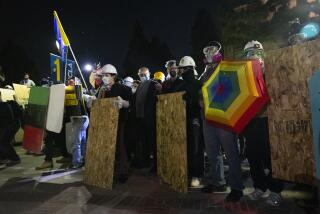Times photographer Marcus Yam wins Pulitzer Prize

Marcus Yam, a Los Angeles Times journalist with a warrior’s courage and a poet’s heart, won the Pulitzer Prize for breaking news photography on Monday for his poignant and searing pictures of last summer’s fall of Kabul, Afghanistan, to Taliban fighters.
Yam delivered pictures of unspeakable tragedy and abiding emotion despite a manhandling by one of the insurgents, the near-constant menace of other fighters and the abundant technical hurdles of transmitting images out of a war zone.
Yam’s prize was for what the judges described as “raw and urgent images of the U.S. departure from Afghanistan that captured the human costs of the historic change in the country.” He shared the award for breaking news photography with four photographers from Getty Images, commended for their “comprehensive and consistently riveting photos of the Jan. 6, 2021, attack on the U.S. Capitol.”
His editors said Yam employed an “almost radical open-mindedness” to capture scenes that epitomized the chaotic end of the United States’ 20-year occupation of Afghanistan. The resulting pictures are hard to forget:
A young boy’s face, crumpled in anguish as a bloodied child is carried to safety; Taliban gunmen, bowing in prayer over their shoes and assault rifles; a family, praying for loved ones killed in an errant U.S. drone strike, as another American aircraft flies overhead; and two local journalists, stripped to their underwear to reveal the scarlet wounds of a savage beating.
The 2022 Pulitzer Prize for Breaking News Photography goes to Marcus Yam, the sixth L.A. Times journalist to win a Pulitzer for photography categories.
Yam’s award was the 49th Pulitzer Prize for The Times since 1942, including six gold medals for public service.
The Times was also named a finalist in the breaking news category for its coverage of the accidental shooting death of a cinematographer on the set of the low-budget western “Rust.” The paper dominated reporting on the tragedy, revealing unsafe working conditions on the set and shortcuts taken by some producers of the film, which starred Alec Baldwin.
The New York Times won three awards, more honors than any other outlet. Its journalists and contributors took prizes for national reporting for an expose on a disturbing pattern of fatal traffic stops by police, for international reporting for its accounts of the fall of the Afghan government and for criticism for commentaries on Black contributions to art and popular culture.
The Washington Post won the public service prize, considered the top honor in the annual competition, for its detailed recounting of the Jan. 6, 2021, insurrection at the U.S. capitol and its underpinnings. Judges said the Post’s account gave the world “a thorough and unflinching understanding of one of the nation’s darkest days.”
A special citation from the Pulitzer Prize board also went to the journalists of Ukraine “for their courage, endurance and commitment to truthful reporting during Vladimir Putin’s ruthless invasion of their country and his propaganda war in Russia.”
Dr. Patrick Soon-Shiong, owner and executive chairman of The Times, recalled in a videoconference with the paper’s staff how proud and scared he was last summer as he followed Yam’s harrowing coverage.
“You were out there doing amazing things,” Soon-Shiong said. “What you’ve done, with the photography and the images, was so important for the world. The word ‘genocide’ really needs to be said. And your pictorial really brings it home. It’s really important.”
Yam, 38, was born and raised in Kuala Lumpur, Malaysia. He became a photographer after leaving a career in aerospace engineering and joined The Times in 2014.
He has been honored in the past with national awards for photographs documenting the everyday plight of people enduring deadly clashes in the Gaza Strip. He was part of two Pulitzer Prize-winning breaking news teams — one, for The Times, that covered the San Bernardino terrorist attacks in 2015; and another that reported on the deadly landslide in Oso, Wash., in 2014, for the Seattle Times.
He has been recognized with an Emmy Award for news and documentary, World Press Photo Award, Dart Award for Trauma Coverage, Scripps Howard Visual Journalism Award, Picture of the Year International’s Newspaper Photographer of the Year Award, Society of Professional Journalists’ Sigma Delta Chi Award, National Headliner Award and Alfred I. duPont-Columbia University Award.
L.A. Times photographer Marcus Yam was assaulted and detained by Taliban members. Then they gave him a Monster Energy drink.
Yam laid the groundwork for his coverage of the Taliban’s blitzkrieg takeover of Afghanistan with diligent previous work in the country. One foray into the country with a writing colleague produced profiles of Afghans whose life spans coincided with the duration of the long war, young women who had never known Taliban rule, and musicians facing a ban on the vocation they loved.
In the summer of 2021, the Taliban’s lightning-fast advance and his instincts told Yam that the capital, Kabul, would soon fall. He packed his gear in 20 minutes and flew out of his temporary base in Lebanon, with just five minutes to spare.
Yam’s editors said that in words and actions, he and his reporting partner, Nabih Bulos, made clear to locals that they would treat combatants and civilians with respect and dignity. Their repeated visits to the Kabul airport and contacts with the fighters manning the gates meant that — by the time a final, desperate airlift of refugees occurred — The Times journalists had extraordinary access.
His editors told the Pulitzer judges: “Thoughtful gestures like going to say goodbye to a family decimated by an airstrike led to a revelation that propelled the story forward — that they had not received any apology or compensation.”
Five days into his odyssey, Yam documented a showdown between the Taliban and supporters of the outgoing government. In the midst of the tense scene, he was set upon by a tall fighter, who hit him repeatedly in the head and demanded that he delete the photos he had been taking.
Instead, Yam repeatedly identified himself and pleaded for the right of journalists to record the conflict. Before the encounter ended, the aggressors were apologizing and offering Yam and another journalist energy drinks, and requesting that they pose for selfies.
The Taliban swept into Kabul and seized power on Sunday after President Ashraf Ghani fled the country.
“We obliged, but I didn’t smile,” Yam wrote in his first-person account of the episode. A fixer’s car had been called. “We jumped in the car and raced away,” Yam recalled. “It wasn’t even noon yet, and the temperature was scorching. I went home and iced my injuries. I hoped they wouldn’t get too black and blue.”
In a phone call later that day, Yam told Times foreign editor Jeffrey Fleishman about an array of logistical concerns, including finding a new driver. In a congratulatory Zoom call with the paper’s staff Monday, Fleishman recalled how the understated Yam added, almost as an afterthought: “Oh, yeah, and I got beat up by the Taliban.”
Yam thanked his colleagues Monday, saying his work wouldn’t have been possible without the collaboration of many, including Bulos, the paper’s Middle East correspondent, and Calvin Hom, the executive director of photography.
He concluded by dedicating his award to the people whose images he captured, noting the erosion of freedoms they face under the Taliban.
“The bravery and the courage really belongs to everyday Afghans, whose lives were changed overnight,” Yam said. “As Westerners, we have the privilege of coming and going. And they are the ones that have to remain and to face the unknown. So this is for them.”
The Times’ dominant coverage of the shooting death of cinematographer Halyna Hutchins on the “Rust” set began with a scoop by veteran reporter Meg James. She reported that the film’s New Mexico set had been rife with labor tensions and that most of the camera crew had walked out before the shooting because of safety concerns.
James and colleague Amy Kaufman used text messages and other reporting to show that producers had been warned about safety breaches five days before the accident. Reporter Julia Wick wrote a poignant story about the anguish in the New Mexico film community over the shooting.
The reporters credited editors Mary McNamara and Richard Verrier with shepherding the coverage and helping keep The Times ahead of the competition.
Kevin Merida, The Times’ executive editor, praised his staff.
“The work honored today is a reflection of the depth and breadth of L.A. Times journalism, and its consistently high quality,” Merida said. “We are proud of Marcus Yam for the raw power and humanity of his photojournalism in Afghanistan. And we are proud of our team of journalists who relentlessly pursued every angle of the ‘Rust’ film set tragedy and the impact of it on the industry.”
More to Read
Sign up for Essential California
The most important California stories and recommendations in your inbox every morning.
You may occasionally receive promotional content from the Los Angeles Times.
